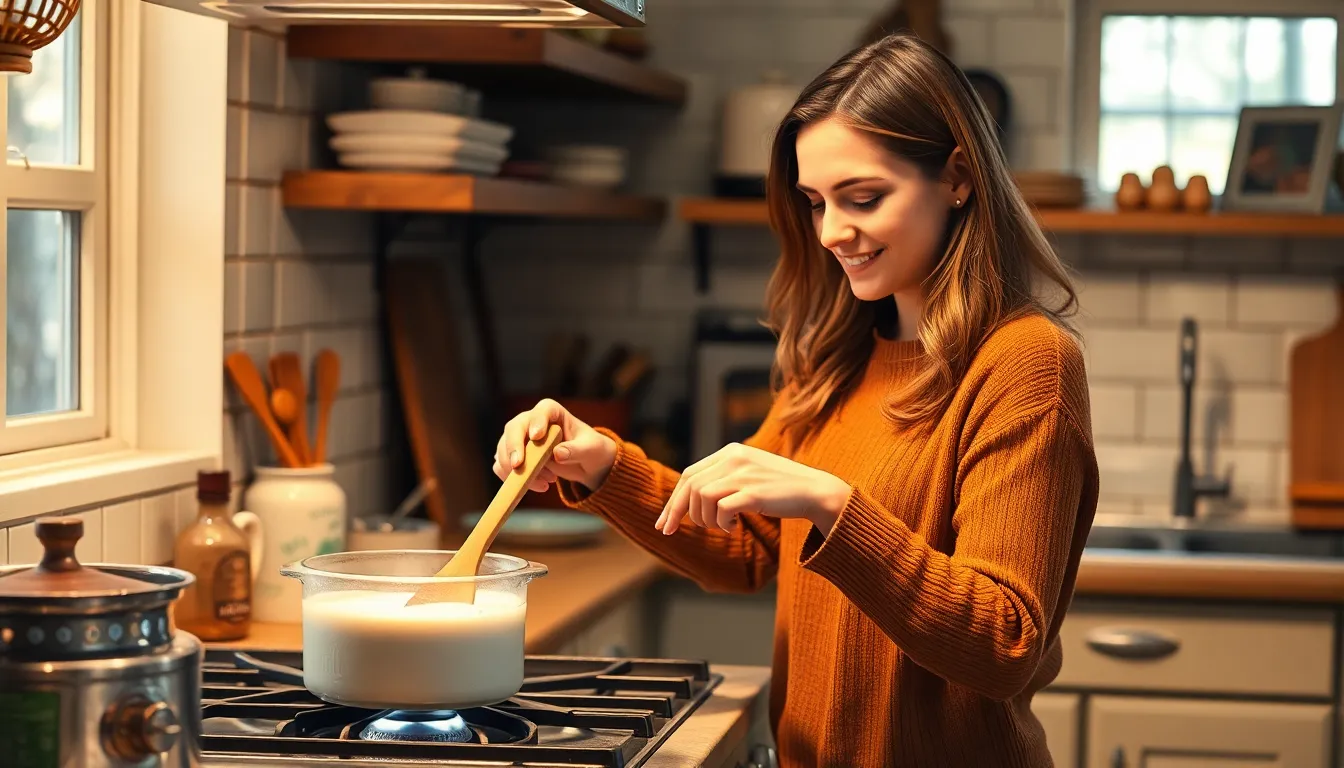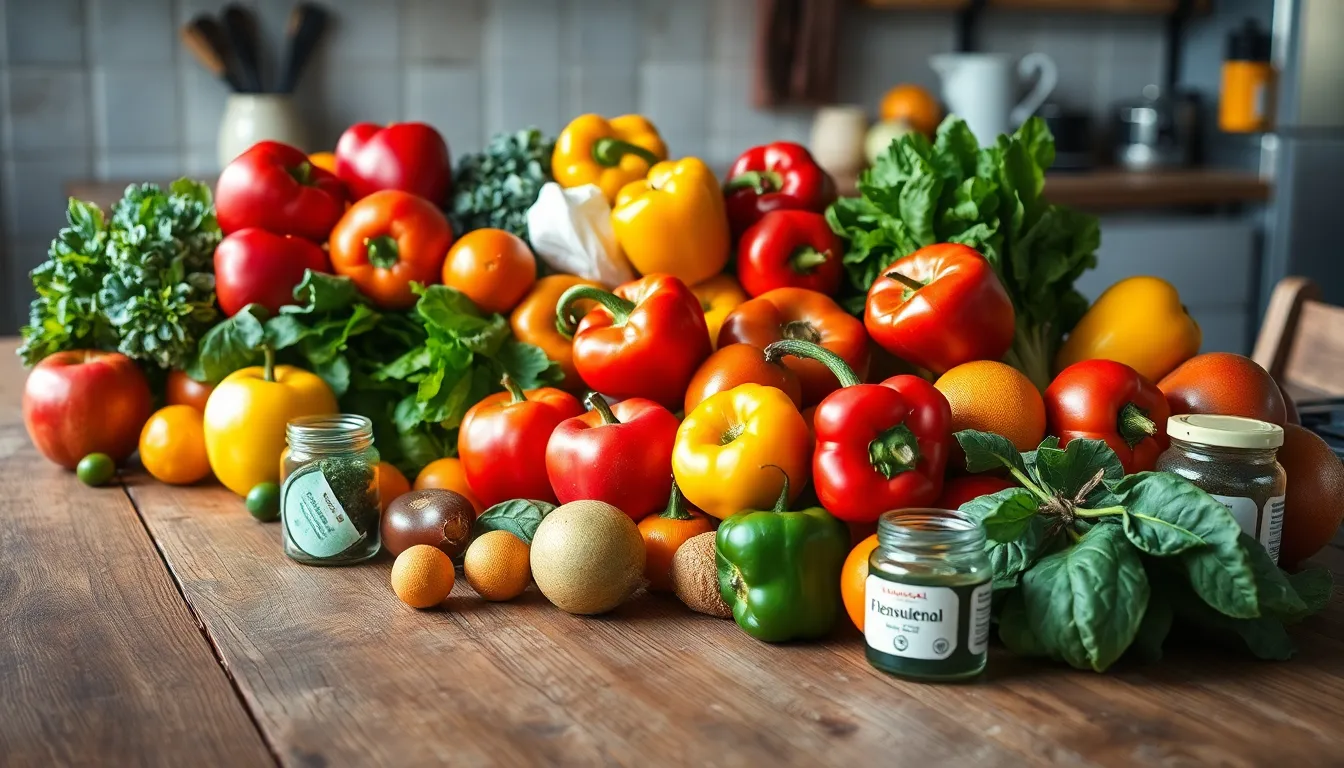Warming up milk might seem like a simple task, but it can turn into a culinary adventure if you’re not careful. Whether you’re crafting the perfect cup of hot cocoa or prepping a creamy béchamel sauce, knowing how to heat milk properly can make all the difference. No one wants a scalded disaster or a lukewarm letdown, right?
Table of Contents
ToggleDifferent Methods To Warm Up Milk
Warming milk can enhance various recipes. Several simple methods exist to ensure milk reaches the desired temperature without scalding.
Stovetop Method
Using the stovetop offers a controlled approach. Pour desired milk quantity into a saucepan. Heat the milk over low to medium heat, stirring gently to prevent scorching. Watch for steam rising, indicating the milk is warming, and avoid boiling, which can alter texture and flavor. If heat is managed correctly, this method ensures even warming.
Microwave Method
The microwave provides a quick and convenient option. Pour the milk into a microwave-safe container. Cover the container with a microwave-safe lid or wrap to trap steam. Heat the milk in 15 to 30-second intervals, stirring between each interval. Checking the temperature regularly prevents overheating. This method allows for fast warming while retaining milk’s quality.
Using A Double Boiler
A double boiler creates gentle heat for warming milk. Fill the bottom pot with water, then place a heat-safe container on top. The water temperature will warm the milk slowly and evenly. This method minimizes the risk of curdling or scalding, making it ideal for delicate recipes. Stir continuously for best results until the milk reaches the right temperature.
Tips For Heating Milk Perfectly

Proper techniques enhance the experience of warming milk. Understanding these methods improves the quality and flavor of various recipes.
Avoiding Scalding
Scalding occurs when milk exceeds 180°F. To prevent this, heaters need to monitor the temperature closely. Utilize a thermometer for accurate readings. Stovetops often require low to medium heat settings to maintain control. Look for tiny bubbles forming on the edges, indicating readiness without boiling. Rushing the process can lead to burning, which alters the flavor. Gentle heat allows milk to warm evenly, preserving its natural sweetness and texture.
Stirring Techniques
Regular stirring plays a crucial role in heating milk properly. It helps distribute heat evenly, minimizing the risk of hot spots that lead to scalding. Choose a wooden or silicone spatula for stirring, as these materials avoid scratching cookware. Begin stirring from the center and work outward for optimal smoothness. Adjust the stirring frequency based on the heat source; more frequent stirring is essential on a stovetop. Establishing a steady rhythm ensures consistent warmth without interruption.
Common Mistakes To Avoid
Warming milk requires attention to detail. Common mistakes can compromise both taste and texture.
Overheating Milk
Overheating milk leads to scalding, which alters flavor and texture. When milk exceeds 180°F, proteins break down, creating an unpleasant taste. Avoid using high heat settings as it can speed up the process. Instead, opt for low to medium heat to ensure even warming. Checking the temperature with a thermometer helps maintain the ideal range. Look for tiny bubbles forming around the edges, indicating that the milk is near the right temperature. Stirring continuously promotes even heating and prevents hot spots, protecting the milk’s natural sweetness.
Ignoring Milk Type Differences
Not all milk is created equal. Whole milk, skim milk, and almond milk require different warming approaches. Fat content and composition impact how the milk heats up and behaves. Whole milk warms more slowly due to its higher fat content, while non-dairy alternatives can heat faster. Failing to adjust the heating method according to the milk type can result in curdling or burning. Always consider the specific characteristics of the milk in use to ensure a perfect warming process. Adapting techniques enhances quality and preserves the unique flavors of each variety.
Benefits Of Warming Milk
Warming milk enhances its flavor and texture, making it suitable for various dishes. It promotes a creamy consistency in beverages like hot cocoa and enhances the richness of sauces, such as béchamel. Improved palatability results when milk is warmed properly, as it unlocks its natural sweetness.
Heating milk also facilitates digestion. Warm milk can soothe the stomach, promoting easier nutrient absorption. It aids in the release of compounds, helping to relax the digestive system. Consequently, individuals may find it beneficial before bedtime, as it supports a calming effect.
Nutrition plays a crucial role as well. Heating milk preserves essential nutrients while making others more bioavailable. For instance, warming increases the absorption of vitamins and minerals, such as calcium and vitamin D. Thus, individuals gain maximum benefits when incorporating warm milk into their diets.
Additionally, warming milk significantly extends its versatility. It allows for seamless incorporation into recipes, ensuring flavors meld together harmoniously. Various culinary techniques thrive on warmed milk, and this adaptability aids creative cooking. Warming can also serve as a prelude to frothing, enhancing the texture of coffee drinks like lattes.
Adaptation to different milk types matters too. Whole, skim, and non-dairy alternatives respond uniquely to heat, requiring specific warming methods. Recognizing these differences ensures optimal results and prevents curdling or burning. Proper techniques lead to satisfying outcomes in both flavor and consistency.
Ultimately, understanding the benefits of warming milk enhances culinary experiences. With proper warming, individuals unlock new dimensions in flavor while improving digestion. The overall quality of recipes improves considerably with warmed milk, making it a staple in many kitchens.
Warming milk correctly is essential for achieving the best flavor and texture in various recipes. By choosing the right method and paying attention to temperature, anyone can avoid common pitfalls like scalding or curdling.
Whether opting for the stovetop, microwave, or double boiler, each technique offers unique advantages that cater to different cooking styles.
Incorporating warmed milk into dishes not only enhances taste but also promotes better digestion and nutrient absorption. With these insights, anyone can confidently elevate their culinary creations, making warm milk a valuable ingredient in their kitchen.






